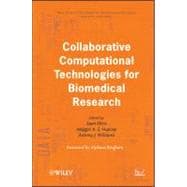
Note: Supplemental materials are not guaranteed with Rental or Used book purchases.
Purchase Benefits
Looking to rent a book? Rent Collaborative Computational Technologies for Biomedical Research [ISBN: 9780470638033] for the semester, quarter, and short term or search our site for other textbooks by Ekins, Sean; Hupcey, Maggie A. Z.; Williams, Antony J.; Bingham, Alpheus. Renting a textbook can save you up to 90% from the cost of buying.
| Foreword | p. xi |
| Preface | p. xv |
| Contributors | p. xix |
| Getting People to Collaborate | p. 1 |
| The Need for Collaborative Technologies in Drug Discovery | p. 3 |
| Collaborative Innovation: The Essential Foundation of Scientific Discovery | p. 19 |
| Models for Collaborations and Computational Biology | p. 39 |
| Precompetitive Collaborations in the Pharmaceutical Industry | p. 55 |
| Collaborations in Chemistry | p. 85 |
| Consistent Patterns in Large-Scale Collaboration | p. 99 |
| Collaborations Between Chemists and Biologists | p. 113 |
| Ethics of Collaboration | p. 121 |
| Intellectual Property Aspects of Collaboration | p. 133 |
| Methods and Processes For Collaborations | p. 147 |
| Scientific Networking and Collaborations | p. 149 |
| Cancer Commons: Biomedicine in the Internet Age | p. 161 |
| Collaborative Development of Large-Scale Biomedical Ontologies | p. 179 |
| Standards for Collaborative Computational Technologies for Biomedical Research | p. 201 |
| Collaborative Systems Biology: Open Source, Open Data, and Cloud Computing | p. 209 |
| Eight Years Using Grids for Life Sciences | p. 221 |
| Enabling Precompetitive Translational Research: A Case Study | p. 241 |
| Collaboration in Cancer Research Community: Cancer Biomedical Informatics Grid (caBIG) | p. 261 |
| Leveraging Information Technology for Collaboration in Clinical Trials | p. 281 |
| Tools for Collaborations | p. 301 |
| Evolution of Electronic Laboratory Notebooks | p. 303 |
| Collaborative Tools to Accelerate Neglected Disease Research: Open Source Drug Discovery Model | p. 321 |
| Pioneering Use of the Cloud for Development of Collaborative Drug Discovery (CDD) Database | p. 335 |
| Chemspider: a Platform for Crowdsourced Collaboration to Curate Data Derived From Public Compound Databases | p. 363 |
| Collaborative-Based Bioinformatics Applications | p. 387 |
| Collaborative Cheminformatics Applications | p. 399 |
| The Future of Collaborations | p. 423 |
| Collaboration Using Open Notebook Science in Academia | p. 425 |
| Collaboration and the Semantic Web | p. 453 |
| Collaborative Visual Analytics Environment for Imaging Genetics | p. 467 |
| Current and Future Challenges for Collaborative Computational Technologies for the Life Sciences | p. 491 |
| Index | p. 519 |
| Table of Contents provided by Ingram. All Rights Reserved. |
The New copy of this book will include any supplemental materials advertised. Please check the title of the book to determine if it should include any access cards, study guides, lab manuals, CDs, etc.
The Used, Rental and eBook copies of this book are not guaranteed to include any supplemental materials. Typically, only the book itself is included. This is true even if the title states it includes any access cards, study guides, lab manuals, CDs, etc.